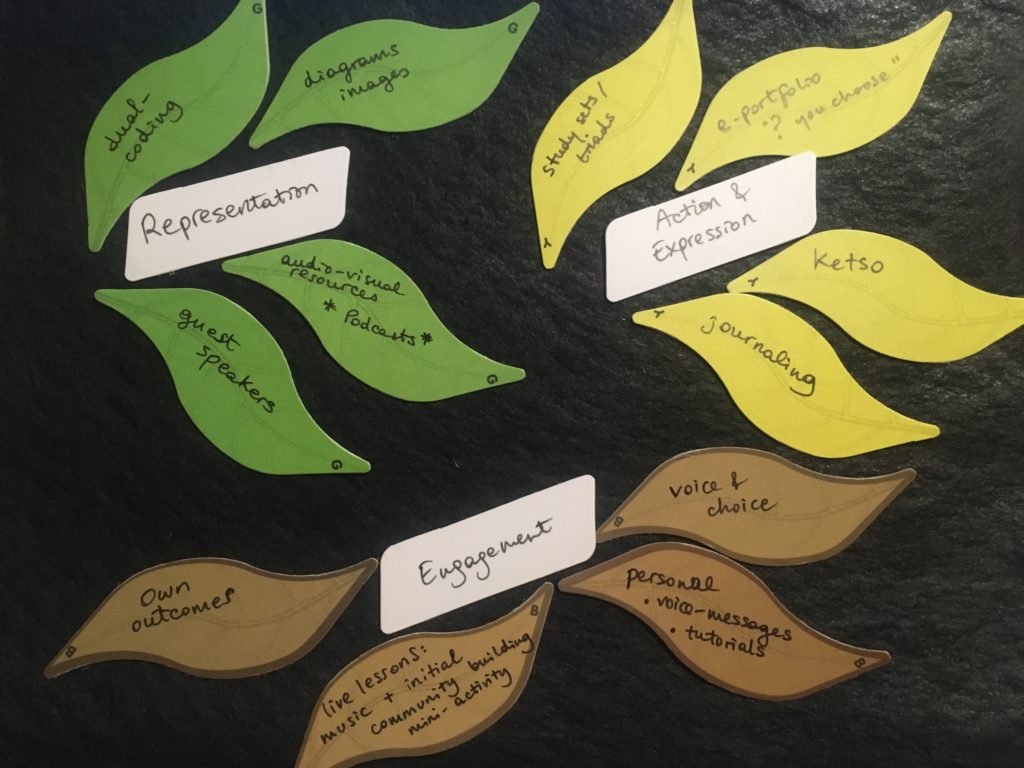Rear-view mirror from a UK perspective
Reflecting about practice through the lens of Universal Design for Learning principles and practices to inform learning design
Blog post by
Virna Rossi, Ravensbourne University London, United Kingdom, March 2021
Months of pandemic teaching and learning have highlighted issues of access and accessibility, which have disproportionally affected some under-served student populations. Students and teachers are experiencing the literal meaning of the word ‘distraction’, from the Latin dis (apart) + trahere (to drag): we are all being dragged apart, pulled in many different directions. Hence, intentionally designing inclusive learning experiences is crucial to support our students at this time. But we also need the students’ help to evaluate the effectiveness of our learning design.
Universal Design for Learning (UDL) helps us design more inclusive learning experiences. It is an approach to curriculum design that minimises barriers and maximises learning for all students.
The 3 UDL principles are based on 3 primary neurological networks: UDL is based on brain science. The 3 networks are: affective, recognition and strategic ‘which refer to the why, what and how’ of learning. Based on these, there are 3 UDL principles: Engagement, Representation and Action & Expression. More on this below.
UDL should particularly be used at the start of the learning design process, to intentionally drive the process, ideally in collaboration with students. However, UDL principles and practices can also be used as a professional reflection and evaluation tool during and after the learning event. Once more, this would ideally involve the students.
A metaphor to illustrate the use of UDL principles as a tool for reflection is to see them as rear-view and side mirrors. The universal use of rear-view and side mirrors has changed the status of humans from a species only capable of perceiving the field of vision ahead, to one which can understand in a single glance two opposing visual fields. In cars, the inner rear-view mirror and the two side ones provide different angles of the same ‘scene’ behind, virtually eliminating blind spots. Each of the 3 mirrors informs the driver’s driving decisions, with very little effort, on the go.
The 3 rear/side mirrors can be seen as the 3 UDL principles against which to gauge how inclusive our learning design is. The 3 mirrors provide 3 perspectives to evaluate our practice.
Why do we glance?
We glance at the rear and side-view mirrors to inform our driving, to avoid accidents, to check the state of the road, to situate ourselves, to change our trajectory. These are the same reasons why we should reflect ‘on’ and evaluate our teaching, in particular our learning design. This reflective and evaluative exercise provides us with a series of dynamic snapshots about our practice and the learning we are prompting.
At times there is a safety warning on the side mirrors: ‘objects in mirror are closer than they appear’. In our metaphor this also has an equivalent: some situations may need attention as a priority because we might underestimate the closeness and relative importance of some aspects of our learning design. For instance if we have dyslexic students – Have we provided judicious output choices? How well equipped are they for their upcoming assessment? What study support systems are in place?
When do we glance?
We do it while we drive. So we can reflect on and evaluate our learning design while the learning experience is happening, we can indeed make it part of the learning experience itself. The 3 UDL rear/side-mirrors can be used as a quick evaluative checkpoint, like a brief ‘glance’ while driving.
End-point course reviews are common practice, but as teachers we will not be able to action any feedback for that same cohort on that course at that point. In a way, it is like checking the rear-view mirror after a collision from behind which we could have avoided by checking earlier.
For this reason, at least one mid-term or mid-course evaluation point is much more valuable in terms of informing our practice for that cohort.
Using our metaphor, as we drive and check the scene behind, some of the vehicles behind us at times overtake us or come alongside us (with thanks to David Baume for mentioning this point in a live event). So, in our metaphor, the reflection and evaluation exercise is not of a still image, but is one of a dynamic nature because we are dealing with a moving scene, with a living learning process. It is a learning journey in the making.
How do we glance? A case study
I used UDL as the main learning design framework for our internal staff development course (PGCert) from the outset. I articulated this to the students even before the start of the course. But I also used the 3 lenses of UDL principles for mid-term review (the 3 rear/side mirrors), during one of our live lessons on the PGCert to elicit evaluative feedback comments about my PGCert course design, from the users themselves. I wanted to spark dialogue and to gain the student perspective. This was part of a 360 degree feedback approach, which invites the literature input, our own reflections and students’ views as part of a wider-angle feedback view.
The literature view
I started by discussing the theory underpinning UDL principles and guidelines, by means of this visual aid:
This provided the theoretical and best practices grounding.
The students’ view
We used Ketso to represent our reflection and evaluation. This is a hands-on learning aid and workshop tool. It has been adapted for remote teaching, with each learner sent their own pack to develop their ideas in their learning space.
Students used the reusable, moveable pieces to represent their ideas, then arranged them on the felt workspace. The white shapes were used to label the UDL principles, and ideas for each principle were developed on the 3 different colour leaves (a colour for each principle).
Students discussed their ideas in their study sets, in breakout rooms, and uploaded images of their Ketso representations onto this Padlet. The main question was: How are the 3 UDL principles evident on our PGCert course? How can UDL practices be enhanced on a PGCert?
My self-feedback
I also made a Ketso representation to highlight some of the ways I intentionally used UDL principles to drive my PGCert learning design process.

The outcomes of the exercise for me was gaining much-needed insight into how the students were experiencing UDL on the course and where to improve.
For instance, for Engagement, many mentioned that using Ketso was a very good way to be engaged in the course. For Action & Expression, some mentioned that they would welcome more ‘debates’ during the live lessons.
How do students benefit from glancing?
What are the benefits for students in using the 3 rear/side view UDL lens as a reflective and evaluative mid-course review?
Firstly, this enhances students’ meta-cognition and their ability to articulate their learning about learning.
Secondly, understanding UDL principles can equip students with ideas and vocabulary to provide more meaningful feedback on any course design, not just on the PGCert.
Thirdly, this exercise should inform immediate enhancements in course design and delivery. In our case, we discussed some of the suggested enhancements mentioned on the students’ Ketsos, and I immediately implemented needed changes.
Conclusion: adjust/clean the mirrors
The 3 UDL rear/side mirrors help us adjust our practice.
If we already are UDL champions, can we keep growing in our understanding of UDL principles and practices? Can students and colleagues suggest further ways to enhance our practice? This would be like adjusting or cleaning the mirrors so that we can better see how to evaluate our practice.

Finally: Keep calm, Keep traveling, keep checking the ‘rear-mirrors’
Click here to add your responses and comments via Twitter
Click here to follow the discussions on PADLET
Click here to view the recording of the associated webinar
Find out more
About UDL:
@CAST_UDL
About Ketso: